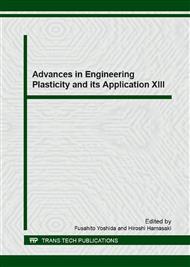p.299
p.305
p.311
p.316
p.322
p.328
p.334
p.339
p.345
Effect of the Non-Associativity of Plasticity Model on the Cyclic Behavior of Geomaterials
Abstract:
The present paper proposed a cyclic plasticity model with a non-associativity parameter, i.e., the model includes non-associative flow rule and associative one. In the present model, the non-associative parameter controls the non-associativity. The model is derived based on the non-linear kinematical hardening rule with two hardening parameters for both the volumetric and deviatoric strains. From the simulation by the present model, we have found the strong non-associativity leads to the large decrease in the mean effective stress, i.e. almost zero mean effective stress during the cyclic deformations under undrained conditions while the model with associated flow rule is not.
Info:
Periodical:
Pages:
322-327
Citation:
Online since:
December 2016
Authors:
Price:
Сopyright:
© 2017 Trans Tech Publications Ltd. All Rights Reserved
Share:
Citation:


